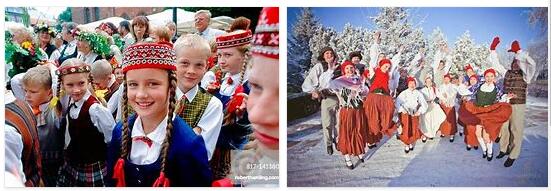The most important and most national part of Latvian folklore is made up of folk songs or dainas (dainot cantare, sonare “).
The question of their age is not yet fully clarified. P. Smits supposes that most of them date back to the Catholic period (XIII-XVI centuries). However, the constructions of the language and the peculiarities of the melody prove that the mythological and ritual dainas are prior to the century. XIII, while the songs with individual melody, of content, lyric-narrative and with migrated motifs, were also formed during the 17th-19th centuries. According to C. Bücher (Arbeit und Rythmus ; Berlin 1909) 73.3% of the dainas were made up of women; according to A. Svābe even 77.4%: a fact that could be explained by the lyric character of the songs, while the Latvians lack a popular epic.
The main mythological character of the dainas is Dievs (lat. Deus) with the primordial meaning of debess (sky), which has no genealogical relationship with the other deities. Next to him act: Laima “La Fortuna”, goddess of destiny and justice; P ē rknos “the Striker” (cfr. Anord. Fjorgyn, lit. Perkunas, Slavic perún). Some “mothers” also play an important part, including the Mother of the ways, the Mother of the earth.
As in Estonian songs, the verse of the dainas is made up of a typical 4-foot trocheo with a dipodia; the use of the dactyl is rarer. According to the statistics of A. Švābe, 85-90% of all songs are made up of a quatrain, which is divided into two couplets or halves. The couplets are linked by the bilateral symmetrical construction (parallelism), obtained stylistically through comparison or analogy. Usually one term of the analogy is taken from life, the other from nature. Large is the use of diminutives and of the past in place of the present in verbs. The rhyme has an occasional character, the alliterations probably have no constructive meaning. The extension of the melody in the prehistoric period does not go beyond the fourth, in the period a. C. and in the Middle Ages it varies between the fifth and sixth; in the modern period it consists of the major and minor ranges. From the melodic point of view the most ancient are the ritual songs (funeral, or for the feast of Jano) which were sung with the accompaniment of trumpets, lyres (kokle) and triangles.
Much less national than the dainas are the legends and sagas. The themes of folk legends are derived for the most part from the usual motifs migrated from Europe, which the Latvian narrator strives to locate and adapt to the social conditions of country life.
National holiday par excellence is that of Jano (23 and 24 June, St. John the Baptist), which however in its manifestations and in its fundamental concept (exaltation of fertility and holiness of nature) shows its connection with the festivals of a pagan divinity, in whose honor fires were lit and oak wreaths intertwined. We should also remember the cult of souls, which is linked to the October oblations of food to the souls of the dead, and that of trees with especially consecrated birch groves. In 1836, in a single country parish, there were 8o of such groves. K. Straubergs explains this cult with animism, A. Švābe with totemism.
